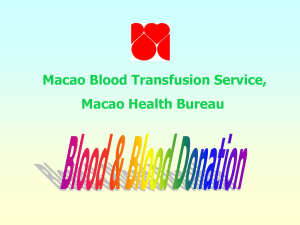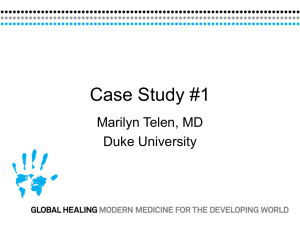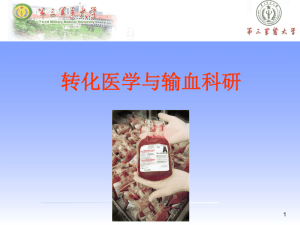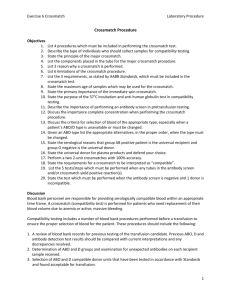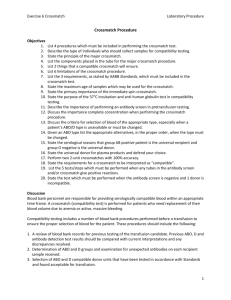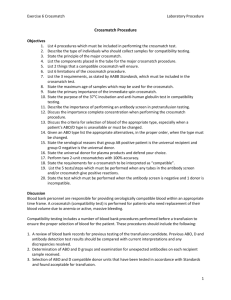MLT 270 Immunohematology - Moberly Area Community College
advertisement
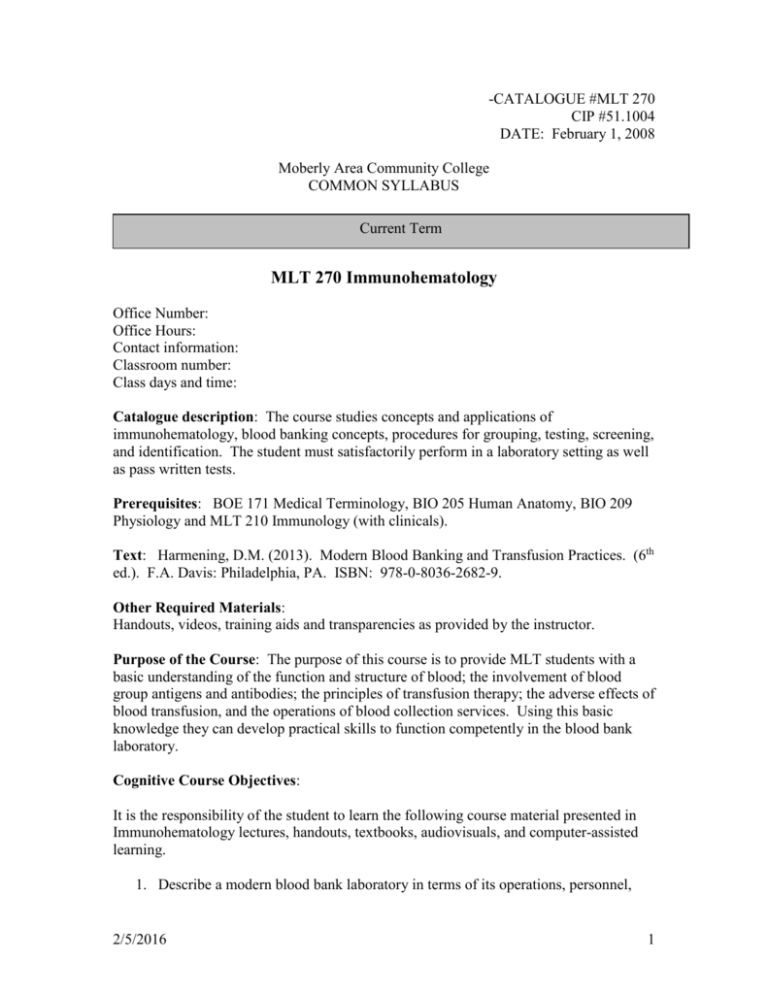
-CATALOGUE #MLT 270 CIP #51.1004 DATE: February 1, 2008 Moberly Area Community College COMMON SYLLABUS Current Term MLT 270 Immunohematology Office Number: Office Hours: Contact information: Classroom number: Class days and time: Catalogue description: The course studies concepts and applications of immunohematology, blood banking concepts, procedures for grouping, testing, screening, and identification. The student must satisfactorily perform in a laboratory setting as well as pass written tests. Prerequisites: BOE 171 Medical Terminology, BIO 205 Human Anatomy, BIO 209 Physiology and MLT 210 Immunology (with clinicals). Text: Harmening, D.M. (2013). Modern Blood Banking and Transfusion Practices. (6th ed.). F.A. Davis: Philadelphia, PA. ISBN: 978-0-8036-2682-9. Other Required Materials: Handouts, videos, training aids and transparencies as provided by the instructor. Purpose of the Course: The purpose of this course is to provide MLT students with a basic understanding of the function and structure of blood; the involvement of blood group antigens and antibodies; the principles of transfusion therapy; the adverse effects of blood transfusion, and the operations of blood collection services. Using this basic knowledge they can develop practical skills to function competently in the blood bank laboratory. Cognitive Course Objectives: It is the responsibility of the student to learn the following course material presented in Immunohematology lectures, handouts, textbooks, audiovisuals, and computer-assisted learning. 1. Describe a modern blood bank laboratory in terms of its operations, personnel, 2/5/2016 1 facilities, and equipment. 2. Discuss the structure, composition and preservation of red blood cells and platelets as they relate to transfusion therapy. 3. Demonstrate an understanding of genetics at three levels, population, cellular and molecular as it pertains to inheritance of blood groups and testing in immunohematology. 4. Explain how principles of immunology relate to blood banking. 5. Characterize blood group antibodies: polyclonal and monoclonal, naturally occurring and immune, expected and unexpected, alloantibodies and autoantibodies, warm and cold. 6. Discuss factors that influence agglutination reactions when performing blood bank testing. 7. Compare tube, gel and solid phase techniques in ABO and Rh typing,antibody detection and compatibility testing. 8. Explain the principles of the antiglobulin test, application of it in blood bank testing, factors that affect the test and sources of error. 9. Discuss the ABO blood group system, reciprocal relationship between ABO antigens and antibodies, frequencies, subgroups, phenotypes and effects of disease. 10. Interpret the results from ABO typing and resolve discrepancies if present. 11. Discuss the Rh blood group system, the Fisher-Race and Wiener nomenclature and theories of Rh inheritance, antigen and antibody detection, characteristics of Rh antibodies and clinical considerations. 12. Interpret the results from an Rh typing and resolve discrepancies. 13. Discuss the basic concepts of antigens and antibodies in the Lewis system and their clinical and biological significance. 14. Discuss the basic concepts and crossmatch problems involving the following major blood group systems: MNS, P, Ii, Kell, Duffy, Kidd and Lutheran. 15. State criteria for acceptable blood donors. 16. Describe autologous donation rules and requirements. 17. State the tests required for allogeneic, autologous and pheresis donation, acceptable intervals and labeling criteria. 18. Identify the storage conditions, shelf life, quality control requirements, indications for use and adverse reactions and laboratory evaluation of adverse reactions for the following: RBC’s RBC’s irradiated RBC’s leukoreduced Random platelets Apheresis platelets Random platelets leukoreduced Apheresis platelets leukoreduced Washed RBC’s Washed random platelets Washed apheresis platelets Pooled random platelets Frozen, deglycerolized RBC’s Fresh, frozen plasma Liquid plasma Whole blood modified Cryoprecipitate Granulocyte concentrates Factor VIII concentrates Factor IX concentrates Factor XIII concentrates Rho(D) immunoglobulin Normal serum albumin 2/5/2016 2 Immune serum globulin Plasma protein fraction Antithrombin III concentrates 19. Explain the process for antibody identification including use of the following techniques: Cell panels Enzymes Neutralization Adsorption DAT Elution Titration 20. Explain compatibility testing procedures and protocols under normal and special circumstances. 21. Describe general blood transfusion practices including practices followed under special conditions. 22. Discuss reporting transfusion reaction work-ups. 23. Differentiate the clinical signs and symptoms of the following types of transfusion reactions: Immediate and Delayed Hemolytic Transfusion Reaction Immediate Nonhemolytic Transfusion Reactions Delayed Nonhemolytic Transfusion Reactions 24. Discuss diseases transmitted by transfusion. 25. Compare and contrast Hemolytic Disease of the Newborn when ABO versus Rh is implicated. Psychomotor Course Objectives After completion of the course with instruction and practice in the student lab and at the affiliate site, students are responsible for knowing how to do the following to minimal competency standards: 1. Perform ABO and Rh typing proficiently. 2. Perform Direct (DAT) and Indirect (IAT) Antihuman globulin testing proficiently. 3. Perform a type, antibody screen and crossmatch proficiently. 4. Identify the following antibodies by using a panel: Kell, Duffy, Kidd. 5. Perform a Transfusion Reaction Workup. 6. Utilize prewarming techniques to secure compatible units for crossmatch. 7. Utilize polyethylene glycol and/or LISS and polybrene for antibody enhancement during identification. 8. Utilize gel and/or solid phase technology for type and crossmatch. 9. Perform quality control checks in the blood bank laboratory. 10. Prepare packed red cells and platelets for administration. Affective Course Objectives After completion of the course, students should be able to display the following behaviors and attitudes: 2/5/2016 3 1. Consistently perform blood bank testing with precision, accuracy, and quality. 2. Use good technique in performing blood bank testing. 3. Demonstrate good working knowledge of blood bank theory and use of equipment. 4. Adhere strictly to written procedures and follow verbal technical direction carefully. 5. Use proper quality control measures. 6. Treat laboratory results and issues confidentially. 7. Generate accurate and legible reports. 8. Maintain a clean, orderly working area. 9. Maintain technical competency and emotional stability in times of tension or stress. 10. Communicate effectively with other professional staff in a professional, cooperative, and empathetic manner. Course Outline: I. II. III. 2/5/2016 Immunology for Blood Bankers A. Overview B. Basic immune system genetics C. Immunoglobulins D. Complement E. Characteristics of blood group antibodies 1. Polyclonal and monoclonal antibodies 2. Naturally occurring and immune antibodies 3. Unexpected antibodies 4. Alloantibodies and autoantibodies F. Characteristics and antigen-antibody reactions G. Detection of RBC antigen-antibody reactions 1. Blood samples required for testing 2. Traditional laboratory methods 3. Factors that influence agglutination reactions Antiglobulin Test (Coombs) A. AHG reagents 1. Monospecific 2. Polyspecific B. DAT C. IAT D. Modified and Automated Antiglobulin Test Techniques 1. Low ionic polybrene 2. Enzyme-linked 3. Solid phase 4. Gel test RBC Biology and Preservation A. RBC membrane B. Hemoglobin structure and functions 4 C. RBC preservation D. Anticoagulant preservative solutions E. Additive solutions F. Freezing and rejuvenation G. Platelet preservation IV. Basic Genetics for Blood Bankers A. Mendel’s Laws of Inheritance B. Hardy-Weinberg Principle C. Inheritance patterns D. Cellular genetics 1. Mitosis 2. Meiosis 3. Cell division V. ABO Blood Group System A. Historical perspective B. ABO antibodies C. Inheritance of ABO blood groups D. ABO subgroups E. ABO discrepancies VI. Rh Blood Group System A. History of the Rh system B. Nomenclatures of the Rh system C. Proposed genetic pathways D. Weak D E. Determination of D status F. Detection of Rh antibodies and antigens G. Clinical considerations VII. Lewis System and the Biological Significance A. Basic concepts: Lewis phenotypes B. Lewis antibodies C. Clinical significance VIII. Other Major Blood Group Systems A. MNS blood group system B. P blood group C. Ii Blood Group D. Kell and Kx blood group E. Duffy blood group F. Kidd blood group G. Lutheran blood group IX. Detection and Identification of Antibodies A. Antibody screen 1. Tube technique a. RBC reagents b. Enhancement c. AHG reagents 2. Gel 2/5/2016 5 X. XI. XII. 3. Solid phase B. Interpretation C. Limitations D. Antibody identification E. Additional techniques 1. Selected cell panels 2. Enzymes 3. Neutralization 1. Adsorption 2. DAT and elution 3. Antibody titration F. Providing compatible blood products G. Resolving difficult antibody identification problems Pretransfusion compatibility testing A. Identification, collection and preparation of samples B. Compatibility testing protocols C. Selection of appropriate donor units D. Crossmatch testing 1. Serologic crossmatch tests 2. Immediate spin crossmatch 3. Antiglobulin crossmatch 4. Interpretation of results 5. Resolving incompatibilities 6. Causes of positive results E. Computer crossmatch F. Compatibility testing in special circumstances 1. Emergencies 2. Transfusion of non-group-specific blood 3. Plasma products 4. Intruterine transfusions 5. Neonatal transfusions 6. Massive transfusions 7. Autologous G. Effective blood utilization Automation and Alternative Technologies A. Gel technology B. Solid-Phase Technology Organization of the Blood Bank Facility A. Government agencies 1. Center for Medicare and Medicaid Services (CMS) 2. Food and Drug Administration (FDA) 3. Occupational Safety and Health Administration (OSHA) B. Facilities who collect/Facilities who do not 1. Donor processing 2. Labeling 3. Donor testing 2/5/2016 6 4. Main laboratory C. Sample acceptance D. Routine testing E. Requests for other blood components F. Issue of blood products G. Reference Laboratory H. Personnel XIII. Donor Screening and Component Preparation A. Governing agencies B. Donor screening C. Autologous donors D. Directed donors E. Pheresis donation F. Whole blood collection G. Donor records H. Donor processing I. Automation J. Component preparation 1. Whole blood modified/irradiated 2. RBCs/aliquots/irradiated/leukoreduced/frozen, deglycerolized 3. Platelet concentrates/aliquots/leukoreduced 4. Single-donor plasma 5. Plasma and liquid plasma/pooled plasma 6. Cryoprecipitated antihemophilic factor 7. NovoSeven 8. Factor VIII concentrates 9. Factor IX 10. Factor XIII 11. Immune serum globulin 12. NSA 13. Plasma protein fraction 14. Rh(D) immune globulin 15. Synthetic volume expanders 16. Antithrombin III concentrates K. Labeling of components XIV. Transfusion therapy A. Blood components 1. Whole blood 2. RBCs 3. Leukocyte-reduced RBCs/washed RBCs/frozen and deglycerolized RBCs 4. Platelets 5. Granulocytes pheresis 6. FFP 7. Thawed or liquid plasma 8. Cryoprecipitate 2/5/2016 7 9. Factors 10. Albumin 11. Immune Globulin B. Special considerations for transfusion XV. Transfusion reactions A. Immediate hemolytic transfusion reaction (IHTR) B. Delayed hemolytic transfusion reaction (DHTR) C. Immediate nonhemolytic transfusion reactions D. Anaphylactic reactions E. Bacterial contamination F. Delayed nonhemolytic transfusion reactions XVI. Transfusion-Transmitted Diseases A. Donor testing B. Hepatitis 1. HAV 2. HBV 3. HDV 4. HEV C. HIV D. HTLV-I and II E. CMV F. EBV G. Parvovirus B19 H. Herpesvirus 6 and 8 I. Bacterial contamination J. Syphilis K. Parasites L. Prion XIII Hemolytic Disease of the Newborn and Fetus General Notes: Library assignments, periodicals, computerized modules, and guest speakers may be used as appropriate. Assessment of Student Learning: In both the didactic and the laboratory portions of the course, the student must achieve 78% or greater. Failure to achieve this minimum score will result in dismissal from the program. In the laboratory portion of the course, the final grade will be recorded as “Pass” or “Fail” and registered with the didactic portion. The following grading scale applies to all programs within the Allied Health Division: 100 – 92% = A 83 – 91% = B 78 – 82% = C 66 – 77% = D 65% and below = F 2/5/2016 8 In the lecture portion of the clinical course, the final grade is derived from student performance on examination(s) and/or assignments. Unit exams averaged = 60%; Final exam = 30% Quizzes, case studies, study questions, class participation etc. averaged = 10% TOTAL 100% Grading/Student Assessment of lecture (didactic) portion of the course: Final grade will be composed of the following: 1. Unit exams = 60% 2. Final exam = 30% 3. Quizzes, case studies, participation, assignments = 10% Grading/Student Assessment of laboratory (student laboratory and clinicals) portion of the course: 1. Skills Checklist: Passing is 78% of the total points available 2. Quizzes, practical assessments, or case studies: Passing is 78% of the total points available 3. Professional Behaviors Evaluation: Passing is no less than 78% Final Pass/Fail clinical grade is the average of the Skills Checklist, quizzes, case studies, or practical assessments, and the Professional Behaviors Evaluation. Statement to Connect Course with General Education Outcomes or Technical Program Outcome Statement: In compliance with MACC’S General Education outcomes, the student who successfully completes this course will be able to: I. Demonstrate effective written and oral communication skills. II. Demonstrate an understanding of scientific principles and computational skills and how to use them to solve problems and make informed decisions. Program Outcomes and Assessments: The Allied Health Department continually strives to meet the needs of the Medical Laboratory Technician student through program improvements. This is a cooperative effort that includes input from the faculty, student, Medical Laboratory Technician Advisory Board, and other appropriate agencies or entities. Students are assessed on mastery of the course concepts and essential skills throughout the courses of the Medical Laboratory Technician Program. Other program assessments include clinical performance criteria, essential skills mastery, the clinical process evaluation, ASCP examination scores, placement rates, and follow-up surveys. 2/5/2016 9 Instructor Policies/Expectations: Instructors of this program expect the following from students: 1. Come to class prepared to discuss or apply important concepts by having read the assigned material or reviewed materials for instrument operation. 2. Participate in class by listening, taking notes, and making contributions to discussions. 3. Consult with faculty for clarification of difficult material or additional resources to consult. 4. Respect the learning environment by averting distractions and disturbances such as ringing cell phones and extraneous conversation in class. 5. Treat instructors and fellow students with consideration, concern, and fairness. Academic Dishonesty: MACC board policy is as follows: “Academic dishonesty by students damages institutional credibility and unfairly jeopardizes honest students; therefore, it will not be tolerated in any form.” Forms of academic dishonesty include but are not limited to the following: violations of copyright law, plagiarism, fabrication, cheating, collusion, and other academic misconduct. Incidents of dishonesty regarding assignments, examinations, classroom/laboratory activities, and/or the submission of misleading or false information to the College will be treated seriously. The procedure for handling academic dishonesty is outlined in the Student Handbook (Policy Handbook M.010). In cases of alleged academic dishonesty, the burden of proof is on the student, not on the instructor. Attendance: Students are expected to prepare for and attend all classes and clinical practice. Regular attendance improves probability for success in the program. Habitual tardiness and frequent absences are disruptive to the classroom and cause an unsafe environment in the student laboratory. Instructors carefully plan learning experiences, so it is important as a matter of courtesy and fairness to the class that all individuals be present. Students absent for reasons beyond their control, such as verified personal illness or family illness and/or death, can make up class work. If a student misses so many classes due to extenuating circumstances that the instructor feels the student cannot catch up, the MLT Program Coordinator will send a written report to the Director of Allied Health. Students who miss two consecutive weeks of class during a regular sixteen-week semester or the equivalent ratio of class time during a shorter session will be dropped from that class unless acceptable justification is supplied to the instructor and the Dean of Student Services. Additionally, students who miss more than one-fourth of the class meetings during any scheduled session may be dropped from that class by the instructor if, in the opinion of the instructor, the student does not have a reasonable opportunity to succeed in the class. Tardiness, make-up, and late work: Tardiness to class and clinicals is disruptive and inconsiderate of others. Being on time is mandatory. 2/5/2016 10 Make-up and late work: See the MLT Student Handbook for guidelines. Remember that communication, accountability and responsibility are very important professional behaviors. Refer to the MLT handbook for the following policies: Drop policy Drug/alcohol policy Grade appeal procedure Student code of conduct Student due process and grievance procedure Student rights and privacy act Use of computing resources ADA Statement Students who have disabilities that qualify under the Americans with Disabilities Act may register for assistance through the Office of Access and ADA Services. Students are invited to contact the Access Office to confidentially discuss disability information, academic accommodations, appropriate documentation and procedures. For more information, please call either the Moberly office at (660) 263-4100 x 11240 or the Columbia office at (573) 234-1067 x 12120, or visit our web page at http://www.macc.edu/index.php/services/access-office. 2/5/2016 11




